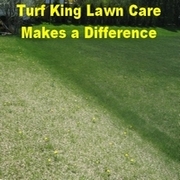Hi Gerry,
Earlier this week Phil came out to treat my lawn for grub prevention. I had the opportunity to talk to him about some dead spots in my lawn. I thought it was due to the drought even though I had been watering. He told me that the grass circles with dead rings around them were indicative of a fungus. Phil suggested overseeding using a black loam and a disease resistant (ie. endophyte enhanced grass seed) with a high rye concentration. He said I could not get rid of the fungus but this would mask it.
I went to a Garden centre to see if they had this grass seed and the horticulturist questioned why I would want to mask the problem rather than get rid of the fungus with a sulfur compound. They also did not have a endophyte enhanced grass seed.
I have two questions for you.
1. Why did Phil tell me to mask the problem rather than use sulfur?
2. Where do I get endophyte enhanced grass seed?
I also bought some bags of black top soil when I will overseed. Is this fine instead of black loam?
I would appreciate your opinion before I start to treat the lawn.
Thank you, Andy
Hi Andy
The circle dead spots are caused by Necrotic Ring Spot (NRS) Disease.
Fungicides are rarely of value in treating this disease. Sulphur is used on many fungus diseases. It has not been shown to be very effective in treatment of NRS. It usually is not expensive at the garden centre, so no harm in trying.
Phil is right about the perennial rye grass - in that perennial ryes are much more resistant to the disease than Kentucky blue grass.
Phil was momentarily mixed up about the endophyte. Endophytic perennial rye is used to reduce chinch bug damage.
While using endophytic perennial ryes will help with chinch bugs, it doesn't make a difference with NRS.
The grass seed we use contains perennial rye varieties that are endophytic. If you prefer to use that type let me know and we will be happy to sell you some.
Gerry
The Spectator had an article about crabgrass this morning.
The only problem I have with this article is that it is from the McClatchy-Tribune Newspapers which is US based. The information about the pre-emergent crabgrass preventer doesn't hold true for Ontario. Not unless you've been headed to Buffalo, NY to shop for your lawn care products. http://www.torontosun.com/2011/08/21/some-head-south-for-banned-weed-killer
The only crabgrass preventer that is legal to use in Ontario is Corn Gluten Meal. This organic product will help reduce crabgrass germination, but it is not as effective as the banned product.
i am one of your customers, and am a little disappointed in the results of my lawn. it has a large brown patch. We seed the area regularly as suggested by your company, however the lawn is still brown. We have been told we have chinch bugs, however the lawn doesn't seem to get better. Is there anything we can do to improve the situation ? My neighbours do nothing to their lawns, but they seem to be greener than mine.
==============================================================================
John
Thanks for your email. We appreciate hearing your concerns about your lawn and are sorry to hear that you are having some concerns.
Chinch bugs can be tricky insects. There used to be a product that could be put on early in the summer. Once applied, your chance of having a chinch bug problem was reduced to about one in 50.
Nowadays, with the organic type products, applications are not of any value unless chinch bugs are present. In other words, prevention is no longer possible. Putting on a product before the chinch bugs appear on the lawn will not prevent them. Once chinch bugs get on the lawn, the organics will reduce their population to the point where damage should stop.
However, depending on how much damage has been done to the lawn, the lawn may or may not recover from the damage. Chinch bugs suck the sap from the grass plants. If the damage is minimal, the plants will recover and turn green again. If the damage is severe, the lack of sap can cause the death of the plant. Then even when the chinch bugs have been treated, the dead grass will not turn green.
This year with the severe drought in July, the grass plants were being stressed on 2 fronts - drought and insects.
If there are patches that are slow to recover, the best seeding time of the year is just ahead. Late August through to the end of September is the ideal time to improve the lawn by seeding. The nights are cooler, the morning dew is heavier, and if we do get rain it is less likely to evaporate as quickly as it might earlier in the summer.
There are a number of different way to overseed. Many people will spread a thin layer of black soil on the damaged or thin areas in the lawn. Then spread the grass seed on the soil. Rake the soil lightly to disperse the seed so it is just under the surface. Water 1-2 times daily for 2-3 weeks.
Make sure to use a high quality grass seed mix. Even better, make sure that the mix contains endophytic perennial ryegrasses that will resist chinch bug damage.
Another way to seed the lawn (and this is the way we would do it) is to do a core-aeration on the lawn and then overseed. The seed falling in the aeration holes is protected from drying out as quickly. It will almost certainly germinate. This method is less labour intensive and therefore less expensive than spreading topsoil around.
As to why you have chinch bugs and your neighbours don't, see http://hamiltonturfking.ca/gerrys-blog/203-why-did-i-get-chinch-bugs
We will send out someone to take another look.
Gerry











